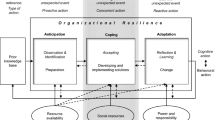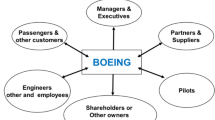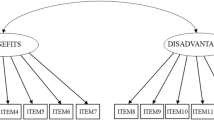Abstract
The main problem facing emergency managers during disasters are insufficient manpower and limited material resources. In emergency situations, the issue of inadequate resources arises from multiple emergency response teams who have different disaster perceptions, and end up allocating assets in an inefficient manner. These varying assessments are a result of erratic levels of involvement by the disaster management, which lead to the weakness of organizational cohesion. This study took Kaohsiung City in southern Taiwan as the subject and conducted a survey through questionnaires to explore the correlations among resource sufficiency, organizational cohesion, and organizational effectiveness in the emergency response. The questionnaires were then analyzed using descriptive statistics, factor analysis, reliability analysis and path analysis. The main conclusions are as follows: (1) Resource sufficiency should be the main priority for emergency response because of its direct correlation with organizational effectiveness, which in turn mediates the organizational cohesion; (2) Senior executives directly affect organizational cohesion and the organizational effectiveness; (3) Quality and quantity of the equipment and personnel have causal relationship with organizational effectiveness.


Similar content being viewed by others
References
Barney JB (1991) Firm resources and sustained competitive advantage. J Manage 17(1):99–120
Becker GS (1964) Human capital. Columbia University Press, New York
Biswas S (2010) Relationship between psychological climate and turnover intentions and its impact on organisational effectiveness: a study in Indian organizations. IIMB Manage Rev 22:102–110
Brockman BK, Morgan RM (2006) The Moderating effect of organizational cohesiveness in knowledge use and new product development. J Acad Market Sci 34(3):295–307
Campbell JP (1977) On the nature of organizational effectiveness. In: Goodman PS, Pennings JM (eds) New perspectives on organizational effectiveness. Jossey-Bass, San Francisco, pp 13–55
Carron AV (1982) Cohesiveness in sport groups: interpretations and consideration. J Sport Psychol 4:123–128
Carron AV, Brawley LR (2000) Cohesion conceptual and measurement issues. Small Group Res 31(1):89–106
Caruso EM, Epley N, Bazerman MH (2006) The costs and benefits of undoing egocentric responsibility assessments in groups. J Personal Soc Psychol 91(5):857–871
Coleman P, Mikkelson L, Larocque L (1991) Network coverage: administrative collegiality and school district ethos in high-performing districts. Can J Educ 16(2):151–167
Coyne KP (1986) Sustainable competitive advantage: what it is and what it isn’t. Bus Horiz 22:54–61
Donahue AK, Joyce PG (2001) A Framework for analyzing emergency management with an application to federal budgeting. Public Adm Rev 61(6):728–740
Edwards RL (1986) Using multidimensional scaling to test the validity of behaviorally anchored rating scales: an organizational example involving the competing values framework. Doctoral Dissertation, State University of New York at Albany
Fatout M, Rose S (1995) Task groups in the social services. Sage, Thousand Oaks
Fayol H (1949) General and industrial management (trans: Storrs C). Pitman, London (Original Work Published in 1916)
Gladstein DL (1984) Groups in context: a model of task group effectiveness. Adm Sci Q 29:499–517
Hair JF, Anderson RE, Tatham RL, Black WC (1995) Multivariate data analysis with reading, 4th edn. Prentice-Hall, Englewood Cliffs, NJ
Huang CF, Hsueh SL (2007) A study on the relationship between intellectual capital and business performance in the engineering consulting industry: a path analysis approach. J Civil Eng Manage 13(4):265–271
Johnson P, Wistow G, Schulz R, Hardy B (2003) Interagency and interprofessional collaboration in community care: the interdependence of structures and values. J Interprof Care 17:69–83
Kalliath TJ, Bluedorn AC, Gillespie DF (1999) A confirmatory factor analysis of the competing values instrument. Educ Psychol Meas 59(1):143–158
Leunes AD, Nation JR (1989) Sport psychology: an introduction. Nelson- Hall, Chicago
Levine JM, Moreland RL (1990) Progress in small group research. Annu Rev Psychol 41:585–634
Lichterman JD (2000) A “community as resource” strategy for disaster response. Public Health Rep 115(2/3):262–265
Likert RL (1961) New patterns of management. McGraw-Hill, New York
Manning FJ, Fullerton TD (1988) Health and well-being in highly cohesive units of the U.S. army. J Appl Soc Psychol 18(6):503–519
Michalisin MD, Karau SJ, Charnchai T (2004) Top management team cohesion and superior industry returns—an empirical study of the resource-based view. Group Organ Manage 29(1):125–140
Quinn RE (1988) Beyond rational management. Jossey-Bass, San Francisco
Quinn RE, Rohrbaugh J (1983) A spatial model of effectiveness criteria: toward a competing values approach to organizational analysis. Manage Sci 29:363–377
Selznick P (1957) Leadership in administration: a sociological interpretation. Harper and Row, New York
Shaw ME (1981) Group dynamics. McGraw-Hill, New York
Shea GP, Guzzo RA (1987) Group effectiveness: what really matters? Sloan Manage Rev 28(3):25
Smith D (2000) Crisis management teams: issues in the management of operational crises. Int J Risk Manage 2(3):61–78
Taylor FW (1911) The principles of scientific management. Harper and Row, New York
Taylor JC, Bowers DG (1974) Survey of organizations. University of Michigan Institute for Social Research, Ann Arbor
Thacher D (2005) The local role in homeland security. Law Soc Rev 39(3):635–676
Tomer JF (1987) Organizational capital: the path to higher productivity and well-being. Praeger, New York
Towne HR (1886) The engineer as economist. Trans Am Soc Mech Eng 7:428–432
Umiker W (1989) Developing personal managerial support groups. Health Care Super 7(2):43–49
Wallace WA, De Balogh F (1985) Decision support systems for disaster management. Public Adm Rev 45:134–147
Walton RD, Dutton JM, Cafferty TP (1969) Organizational context and interdepartmental conflict. Adm Sci Q 14(4):522–542
Williamson O (1975) Market and hierarchies. Free Press, New York
Yalom ID (1995) The theory and practice of group psychotherapy. Harper Collins, New York
Yukl GA (1998) Leadership in organization, 4th edn. Prentice-Hall, New Jersey
Zheng W, Yang B, McLean GN (2010) Linking organizational culture, structure, strategy, and organizational effectiveness: mediating role of knowledge management. J Bus Res 63:763–771
Acknowledgments
We wish to express our gratitude to EMS members who participated in this study and “2007 Kaohsiung City Reinforcement Disaster Prevention and Protection Plan” sponsored by Kaohsiung City Government.
Author information
Authors and Affiliations
Corresponding author
Rights and permissions
About this article
Cite this article
Huang, CF., Wang, JJ. & Lin, TJ. Resource sufficiency, organizational cohesion, and organizational effectiveness of emergency response. Nat Hazards 58, 221–234 (2011). https://doi.org/10.1007/s11069-010-9662-y
Received:
Accepted:
Published:
Issue Date:
DOI: https://doi.org/10.1007/s11069-010-9662-y




